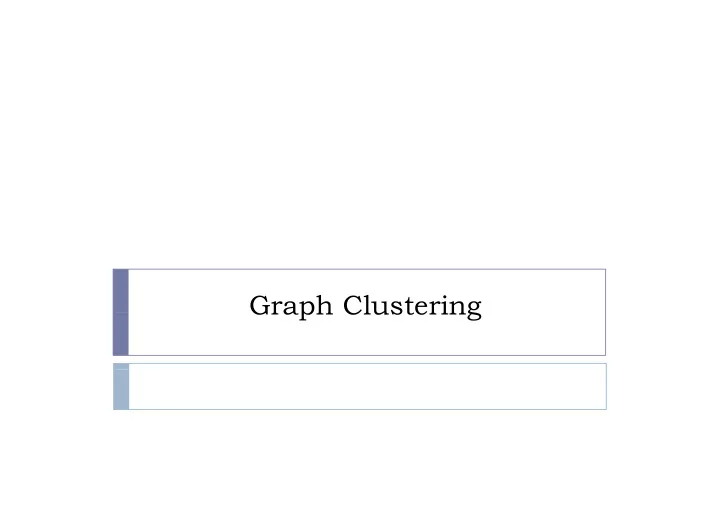

Graph Clustering Graph Clustering
What is clustering? What is clustering? � Finding patterns in data, or grouping similar groups of data-points together into clusters . � Clustering algorithms for numeric data: � Lloyd’s K-means, EM clustering, spectral clustering etc.
Examples of good clustering: Examples of good clustering: IMAGE SEGMENTATION
Graph Clustering: Graph Clustering: � Graphical representation of data as undirected graphs. GRAPH PARTITIONING!!
Graph clustering: Graph clustering: � Undirected graphs � Clustering of vertices on basis of edge structure. � Defining a graph cluster? g g p � In its loosest sense, a graph cluster is a connected component. � In its strictest sense, it’s a maximal clique of a graph. q g p � Many vertices within each cluster. � Few edges between clusters. � Few edges between clusters.
Graph terminology: Graph terminology:
Graph partitioning: Graph partitioning:
Graph Partitioning: Graph Partitioning: � The optimization problem for normalized cuts is intractable (an NP hard problem). � Hence we resort to spectral clustering and approximation algorithms.
More Graph notation: More Graph notation: Adjacency Matrix, A Degree Matrix The properties of the Laplacian of a graph are found to be more interesting for the characterizatiojnof a grpah than the adjacency matrix. The unnormalized Graph Laplacian is defined as Laplacian is defined as
Properties of the Laplacian: Properties of the Laplacian: For every vector 1. L is symmetric and positive definite. 2. 0 is an eigenvalue of the Laplacian with the constant 0 is an eigenvalue of the Laplacian, with the constant 3 3. vector as a corresponding eigenvector. L has n non-negative eigenvalues L has n non negative eigenvalues. 4 4.
Number of Components: Number of Components:
Graph spectra: Graph spectra: � The multiplicity of the eigenvalue 0 gives the number of connected components in the graph.
Graph Generation models: Graph Generation models: � Uniform random model � All edges equiprobable � Poissonian degree distribution � No cluster structure. � Planted partition model � l partitions of vertex set � Edge-probabilities p and q . � Caveman graphs, RMAT generation etc. � Fuzzy graphs?? y g p
General clustering paradigms: General clustering paradigms: � Hierarchical clustering VS flat clustering. � Hierarchical: � T op down � Bottom up
Overview: Overview: � Cut based methods: � Become NP hard with introduction of size constraints. � Approximation algorithms minimizing graph conductance. � M � Maximum flow i fl � Using results by Golberg and Tarjan � Reasonable for small graphs � Reasonable for small graphs. � Graph Spectrum based: � Stable perturbation analysis � Stable perturbation analysis � Good even when graph is not exactly block diagonal. � Typically, second smallest eigenvalue is taken as graph characterstic. � Spectrum of graph transition matrix for blind walk.
Overview: Overview: � Could experiment with properties of different Laplacians. � Typically outperforms k-means and other traditional clustering algorithms. � Computationally unfeasible for large graphs. � Roundabouts?
Voltage potential view: ☺ Voltage-potential view: ☺ � Related to ‘betweenness’ of edges. � Not stable to placement of rando N bl l f d m sources and sinks.
Markov Random walks: Markov Random walks: � Vertices in same cluster are quickly reachable. � A random walk in one of the clusters is likely to remain for a long time a long time. � The Perron-Frobenius theorem ensures that the largest eigenvalue associated with a transition matrix is always 1 eigenvalue associated with a transition matrix is always 1. (relation with Graph Laplacian). � Component of second eigenvector vector of the � Component of second eigenvector vector of the transition matrix serves as a measure of absorption time.
Thank you.
Recommend
More recommend